
A new exhibit at CHM takes a look at the world’s smallest computer – the Michigan “Micro Mote.” Making things smaller has been part of electronics technology since the field’s beginnings. Smaller tends to make things faster and use less power. Recently, researcher Gordon Bell observed that this miniaturization takes place according to a regular pattern and prompts new categories (or ‘classes’ as he calls them) of computer device at more or less regular intervals.
Bell’s Law is a corollary to, and consequence of, Moore’s Law, which tracks the same process of miniaturization in terms of number of transistors. While Moore’s Law provides guidance about the density of integrated circuits, Bell’s Law addresses what kind of computers can be made from those circuits. Bell’s new classes of computer bring with them new markets, ecosystems, and—most importantly—new types of user. Proliferation and miniaturization have been the two forces in the long game of computing.
Roughly every decade a new, lower priced computer class forms based on a new programming platform, network, and interface resulting in new usage and the establishment of a new industry.
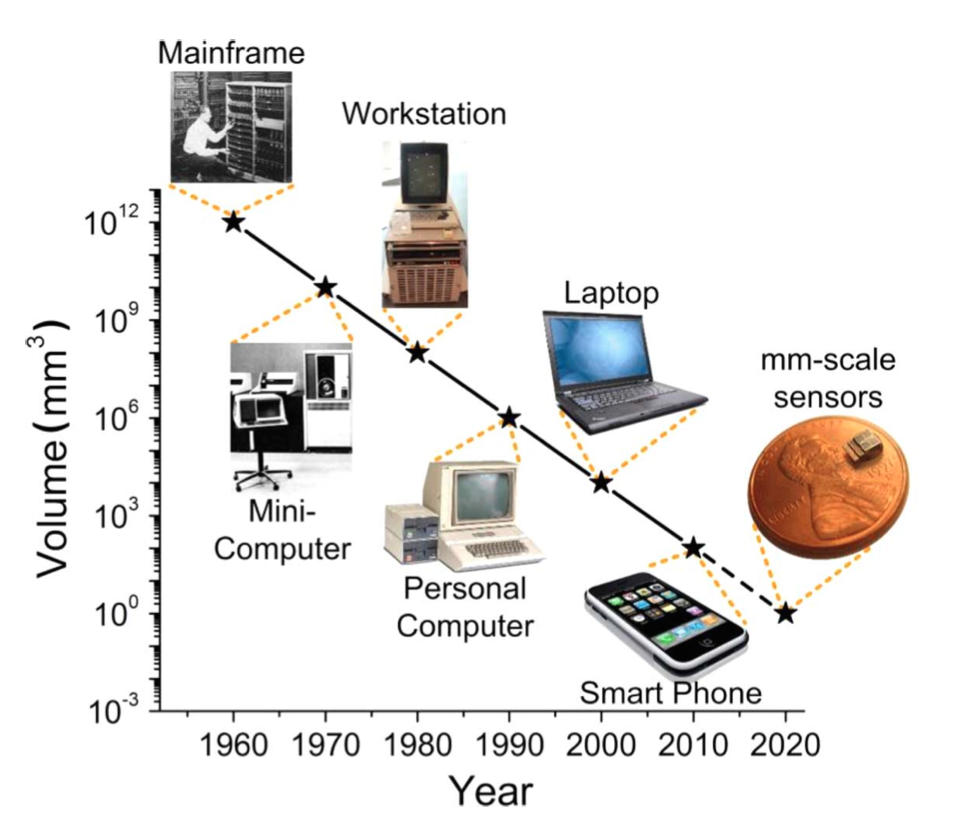
The evolution of computer classes as observed by Bell’s Law
The above graph shows how computer classes have changed over time. For example, on the left of the graph, and covering the years 1955-75, mainframes with volumes in the 1,000,000,000,000 cubic millimeter range (about room-size) were what most computers looked like.
The evolution of platforms and ecosystems moved through minicomputers (microwave oven to refrigerator sized), workstations, personal computers, and so on.
The right-most point on this chart shows millimeter-scale sensors, also known as “motes” or “smart dust,” which, when deployed in large numbers, can form wireless sensor networks (WSNs). Motes are entire computer systems the size of a grain of sand that sense some environmental variable like pressure, temperature, vibration, or light. They are designed to be cheap and ubiquitous, self-powered and able to communicate with each other.
What is smart dust? Smart dust is made up of millimeter-scale self-contained microelectromechanical devices that include sensors, computational ability, bi-directional wireless communications technology, a power supply and the ability to self-organize into ad hoc networks. As tiny as dust particles, smart dust motes can be spread throughout buildings or into the atmosphere to collect and monitor data.

An early vision for smart dust? Vincent van Gogh, The Sower at Sunset.
While the chart shows motes arriving in 2020, smart dust has been here for a while, at least as an idea. Kris Pister at UC Berkeley first coined the term in about 1996, concluding that within a few more years, “We will program the walls and the furniture, and some day even the insects and the dust.” One of the sponsors of Pister’s “Smart Dust” project was DARPA – the Defense Advanced Research Projects Agency, a US research funding agency that supports technologies with possible military potential. Since it’s founding in 1958, DARPA has been a critical force in pushing forward technologies that were at the time speculative and unproven. Some of its notable successes: the internet (via APRANET), GPS, stealth technology, the computer mouse, VLSI design, supercomputing, and (coming soon) driverless cars. DARPA, of course, also develops defense technologies (and all the above spinoffs started as such). DARPA’s vision and reason for supporting the Smart Dust project was to “sprinkle” huge numbers of motes onto a battlefield as a way of gathering intelligence and increasing situational awareness for soldiers on the ground. Since motes talk to each other over wireless networks, they can form a ‘blanket’ of sensors over an area delivering potentially life-saving information in real-time.
But smart dust has applications far beyond this slightly science fiction scenario. Pister lists some of these:
Somewhat speculatively, he continues, “Micro-motors, combined with Smart Dust, raise the interesting possibility of making synthetic insects.” As with all well-intentioned plans, there may be problems with such insects, as Control Agent Maxwell Smart reminds us.
Skipping ahead from Pister’s early and foundational work to the present day, researchers at the University of Michigan under the direction of Professors David Blaauw, Dennis Sylvester, David Wentzlof and Prabal Dutta have recently announced the creation of the “Michigan Micro Mote.” The design is a true breakthrough: an early version—called Phoenix–was so small it could be inserted into the human eye to monitor intraocular pressure, a critical measurement for people with glaucoma.
Today’s version is a multi-layered integrated circuit with built-in solar cells, battery, microprocessor, sensors, radio and memory. The Michigan motes currently come in three types, measuring temperature, pressure or images. (The imager currently outputs images at 160 x 160 pixel resolution).
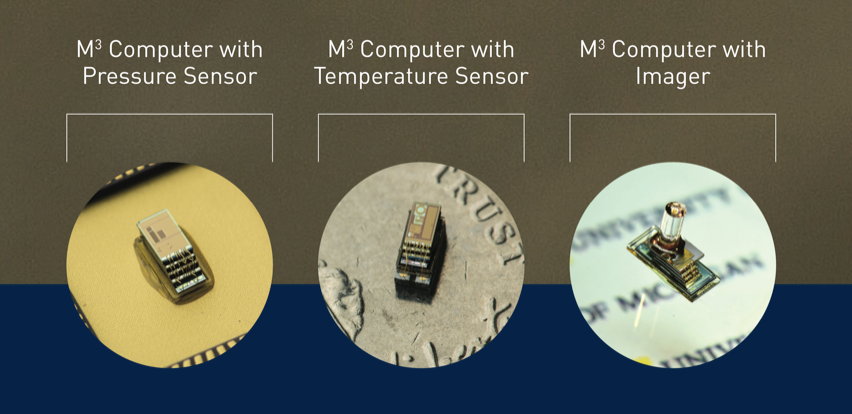
The three types of Michigan Micro Mote
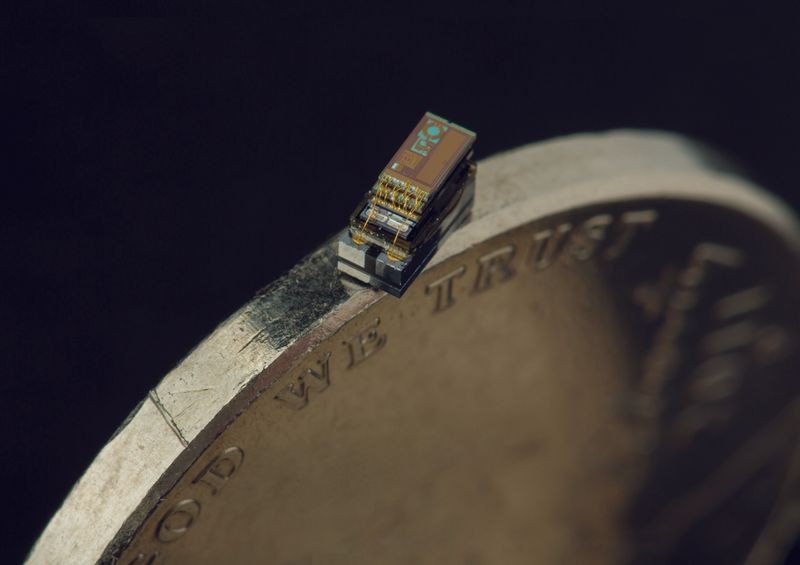
Michigan Micro Mote temperature sensor balanced on edge of a penny
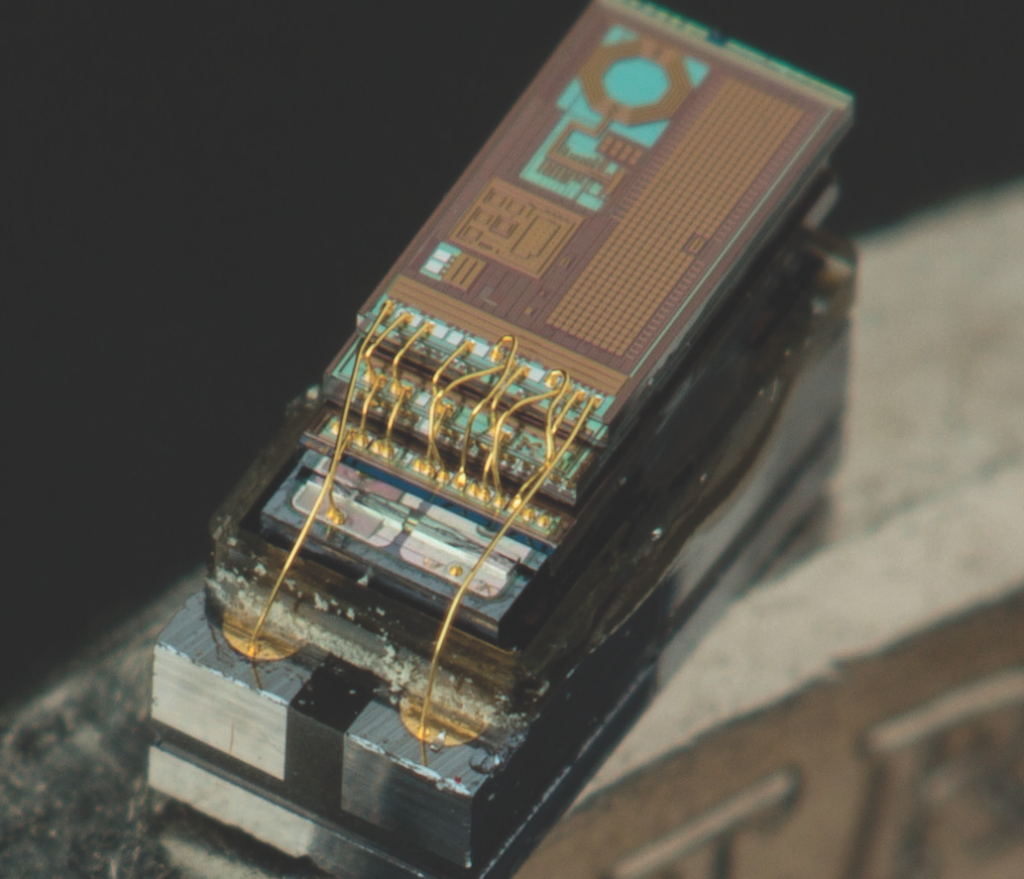
Close-up of the Michigan Micro Mote temperature sensor
Since motes need to be energy-independent, they gain their energy from a battery or by harvesting light energy with a photocell (or both). Some motes can even harvest vibrational, thermal or biological energy. Even better than having enough power though, is not needing it in the first place. To this end, Michigan researchers have reduced the power consumption of the motes to unimaginably small levels. The glaucoma monitor mentioned above consumed only 35 pW of power in standby mode. For an idea of how just how small this is, a single human cell consumes 1 pW.
The Micro Mote is a ‘sandwich’ of either 7 or 8 layers, some of which can be ‘mixed and matched’ to provide specific functionality. Let’s look at the Imager Micro Mote.

Close-up of the Michigan Micro Mote imager
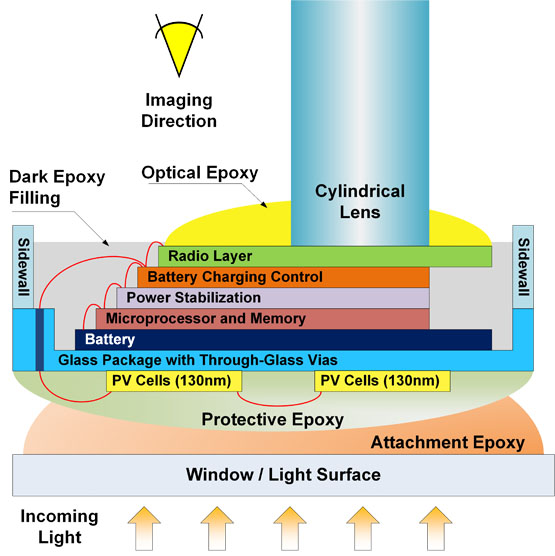
Cross section of the Michigan Micro Mote imager showing individual layers
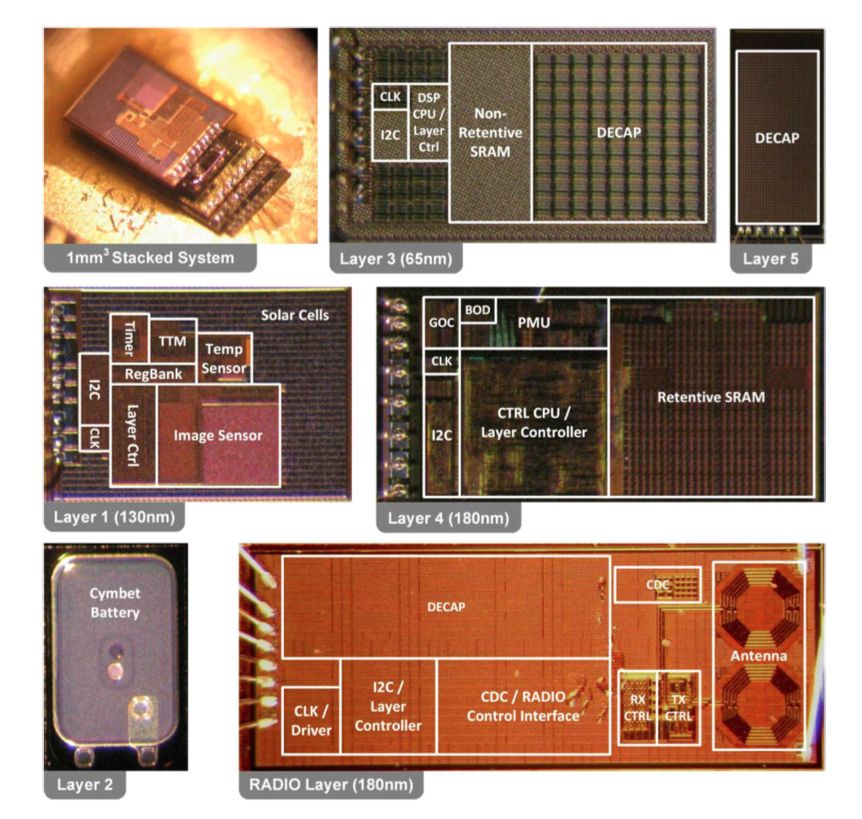
Michigan Micro Mote display in Computer History Museum lobby
The Micro Mote is both evolutionary and revolutionary: Evolutionary in the sense that it makes use of Moore’s Law’s prediction about ever-shrinking circuit sizes; revolutionary in the unique way in which multiple layers are packaged and interconnected to create a single device using infinitesimally small amounts of energy. As predicted by Bell’s Law, as the mote has emerged into a viable computing platform, new applications have come into view:

Michigan Micro Mote display in Computer History Museum lobby
Since seeing is believing, the Computer History Museum, working with the University of Michigan, has created a unique display about the Micro Mote in our lobby.
It’s a simple but effective display: big things come in small packages. Poised on the pointy end of three golf tees are the three types of Micro Mote… a thimble nearby contains many dozens of Micro Motes. Can you guess how many? (Ask at the front desk for the answer). For those of you with a good sense of computer history (and humor), there is also a punched card with a Micro Mote hidden in a single punched hole of the card. (Punched cards were used from the earliest days of computing in the 1940s until about 1980). Consider the implications of that: the hole in the punched card represents a single bit—the Micro Mote, which fits snugly inside it, is a complete computer system.
The potential of motes is fascinating and the technical virtuosity of the Michigan team is nothing short of stunning. It’s extremely difficult working at this scale where power management is so difficult—motes must sip so little energy it’s barely measureable, even with special instruments. The Micro Mote is the result of many years of work by a highly focused research team pushing the boundaries of the possible.
Yet there is also some concern about how motes will be deployed in our world. Like seemingly all technologies, from a hammer to a website, both good and bad outcomes are possible. Most often, good and bad uses of a technology exist at the same time. When it comes to motes, privacy advocates raise issues about undetectable surveillance while medical doctors await clinical applications that will improve patient monitoring. Security experts raise concerns about the potential vulnerability of wireless sensor networks to hacking (a problem especially if they are used in infrastructure applications) while environmental scientists can’t wait to place motes throughout their favorite field or forest canopy.

What is this, a cell phone for ants? How much smaller can things really get? Fictitious male supermodel Derek Zoolander with his ridiculously small cell phone.
Only a few decades ago, these same motes, which can be dropped out of an airplane by the thousands, would have each weighed several tons and occupied a large room. It seems impossible that we have come to this point. Yet the relentless incrementalism of Moore’s Law and the passage of time gets us here. Can we go beyond Micro Motes? Do we need to? Is this the end of Bell’s Law? Stay tuned.
Special thanks to Catherine June and Professors Blauuw and Sylvester at the University of Michigan for their assistance and for donating Micro Motes to the Museum’s permanent collection.